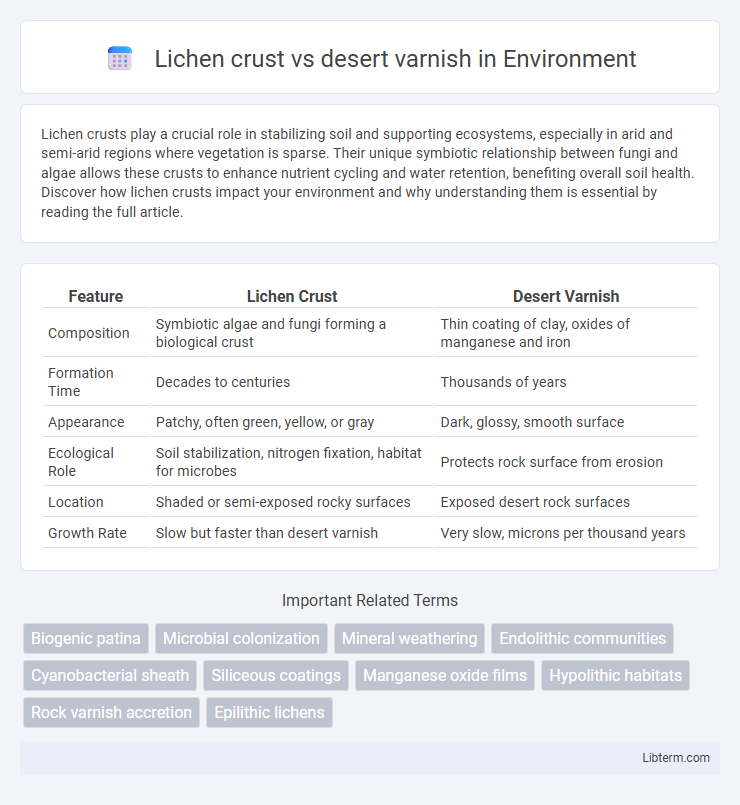Lichen crusts play a crucial role in stabilizing soil and supporting ecosystems, especially in arid and semi-arid regions where vegetation is sparse. Their unique symbiotic relationship between fungi and algae allows these crusts to enhance nutrient cycling and water retention, benefiting overall soil health. Discover how lichen crusts impact your environment and why understanding them is essential by reading the full article.
Table of Comparison
| Feature | Lichen Crust | Desert Varnish |
|---|---|---|
| Composition | Symbiotic algae and fungi forming a biological crust | Thin coating of clay, oxides of manganese and iron |
| Formation Time | Decades to centuries | Thousands of years |
| Appearance | Patchy, often green, yellow, or gray | Dark, glossy, smooth surface |
| Ecological Role | Soil stabilization, nitrogen fixation, habitat for microbes | Protects rock surface from erosion |
| Location | Shaded or semi-exposed rocky surfaces | Exposed desert rock surfaces |
| Growth Rate | Slow but faster than desert varnish | Very slow, microns per thousand years |
Introduction to Lichen Crust and Desert Varnish
Lichen crust consists of symbiotic organisms, primarily fungi and algae, forming a biological layer on rock surfaces in arid environments, contributing to soil stabilization and nutrient cycling. Desert varnish is a thin, dark coating of manganese and iron oxides mixed with clay minerals that accumulates over centuries on exposed rock surfaces in deserts, reflecting slow geochemical processes. Both phenomena influence desert landscapes, but lichen crust is biologically driven, while desert varnish results from abiotic chemical deposition.
Defining Lichen Crust: Characteristics and Formation
Lichen crusts are biological soil crusts composed primarily of symbiotic associations between fungi and photosynthetic partners like algae or cyanobacteria, forming a thin, often colorful layer over surfaces in arid environments. These crusts contribute to soil stabilization, moisture retention, and nutrient cycling by fixing atmospheric nitrogen and carbon through photosynthesis. Unlike desert varnish, which is a chemically formed rock coating rich in manganese and iron oxides, lichen crusts are living organisms that grow slowly over time and respond to environmental changes.
Desert Varnish Explained: Origins and Composition
Desert varnish is a dark, glossy coating found on rock surfaces in arid environments, composed primarily of clay minerals mixed with iron and manganese oxides that accumulate over thousands of years through microbial activity and atmospheric deposition. Its formation involves the slow oxidation of manganese and iron by specialized bacteria, which binds these oxides to rock surfaces, creating a durable patina distinct from lichen crusts. Unlike lichen crusts, which are biological and photosynthetic, desert varnish is abiotic and serves as a record of environmental conditions and weathering processes in desert ecosystems.
Distinguishing Visual Differences
Lichen crust presents as a textured, often colorful coating with green, yellow, or black hues formed by symbiotic algae and fungi growing on rock surfaces. Desert varnish appears as a smooth, glossy dark brown to black patina primarily composed of clay minerals and manganese oxides deposited over long periods. Visual differentiation hinges on lichen's irregular, patchy, and sometimes leafy structures versus desert varnish's uniform, polished, and continuous surface coating.
Formation Processes: Biological vs. Chemical
Lichen crust forms through biological processes where symbiotic algae and fungi colonize rock surfaces, gradually producing organic acids that break down minerals and accumulate biological matter. Desert varnish develops via chemical processes involving the slow oxidation of manganese and iron oxides, combined with dust particles, deposited over time by wind and water. These differing mechanisms result in lichen crust being an active, living coating, whereas desert varnish is an inert, mineral-rich patina.
Environmental Conditions and Geographic Distribution
Lichen crusts form in environments with intermittent moisture and are commonly found in semi-arid to arid regions worldwide, thriving on rock surfaces where moisture supports biological activity. Desert varnish develops over thousands of years in extremely arid deserts, such as the southwestern United States, requiring minimal moisture and high exposure to sunlight to accumulate manganese and iron oxides. Both occur on exposed rocks, but lichen crusts indicate higher moisture availability and biological colonization, while desert varnish signals prolonged dry conditions and geochemical processes.
Ecological Roles and Importance
Lichen crusts play a crucial ecological role in stabilizing soil surfaces, enhancing moisture retention, and facilitating nutrient cycling through nitrogen fixation in arid environments. Desert varnish contributes to ecological balance by protecting rock surfaces from erosion and providing microhabitats for extremophiles. Both formations support biodiversity and maintain ecosystem resilience in desert landscapes.
Methods for Identification and Analysis
Lichen crust identification relies on microscopic examination of fungal and algal components, alongside chemical spot tests to detect lichen acids. Desert varnish analysis commonly employs portable X-ray fluorescence (pXRF) for elemental composition and scanning electron microscopy (SEM) to study mineral layers and manganese/iron oxidation states. Both methods incorporate field observations of texture and color but differ significantly in microscopic and spectroscopic techniques for accurate differentiation.
Human Interaction and Cultural Significance
Lichen crusts have been utilized by indigenous communities for millennia as natural indicators of environmental health and seasonal changes, reflecting deep ecological knowledge and cultural practices. Desert varnish, often found on rock surfaces in arid regions, holds significant archaeological value, with ancient petroglyphs carved into it serving as enduring records of prehistoric human activity and spiritual expression. Both formations contribute to our understanding of historical human interaction with desert landscapes and continue to inspire contemporary art and environmental conservation efforts.
Summary: Key Differences Between Lichen Crust and Desert Varnish
Lichen crust consists of symbiotic organisms, primarily fungi and algae, forming a living, textured surface on rocks that contributes to biological weathering. Desert varnish is a thin, dark coating composed mainly of iron and manganese oxides deposited by abiotic chemical processes over long periods, creating a smooth, inorganic surface. Key differences include the biotic nature and textured morphology of lichen crust versus the abiotic, chemically deposited, and glossy appearance of desert varnish.
Lichen crust Infographic

 libterm.com
libterm.com